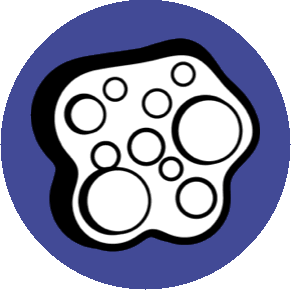 3SPONGES
3SPONGES
Our first multicellular ancestor was a sponge, which appeared about 640 million years ago. The sponge is made up of eukaryotic cells. Every multicellular animal alive today is descended from these ancient sea sponges. Today, science recognizes approximately 5,000 different species of sponges. Of these, about 150 to 200 species live in freshwater.
Evolution: From Single-Celled Eukaryotes to Multicellular Organisms
A dramatic development in the history of our family was the emergence of multicellular animals. For more than two billion years, all creatures on earth were single celled organisms. What happened that made it possible for groups of cells to work together as a unified animal? Because the transition happened so long ago there is barely any fossil evidence. One thing we do know is that the evolution of collagen, a stretchy, elastic protein, played an important role in putting together larger, more complex bodies.
Sponge: Habitat
Scientists think that the first sponges lived in calm, shallow water and most likely fed on algae and bacteria.
Sponge: Body Structure & Feeding
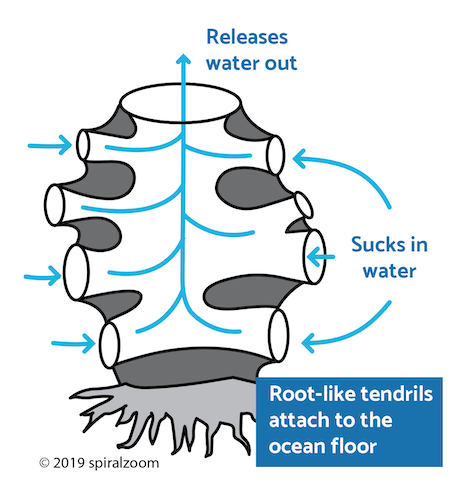
A sponge is a lumpy structure that is organized around a central “chimney” or body cavity. Sponges are anchored to the ocean floor, so they can’t chase food. The food has to come to them.
To get its food the sponge sucks water in through small holes that are distributed across its body. As the water filters through, the sponge absorbs the nutrients, including algae and bacteria. It then releases the water through the central chimney.
Sponges act as giant filters for our oceans, helping to clear the water of debris.
Collagen: Nature’s Glue
All multicellular animals–including sponges and people– have collagen.
Collagen proteins are an elastic, stretchy substance that holds cells together. You might have heard about how collagen is an important part of your skin. Collagen not only holds your skin together, it is also found throughout your body and holds your muscles, organs and other body parts together.
Collagen: Nature’s Rope
Collagen is spiral molecule, similar to the DNA which is a double helix. A triple helix is made of three separate strands. The double helix has two strands. In this way, collagen is similar to twisted rope. Smaller fibers are twisted together in order to make a stronger, larger structure.
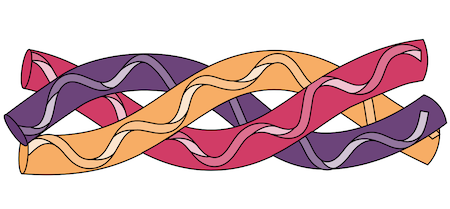
Cells: Specialization
The sponge contains four types of differentiated cells–or cells that each perform a specialized function. The more differentiated cells in a creature, the more complex it is. While a sponge has four different types of specialized cells, scientists estimate that the human body is made from about 200 different types of cells that perform special functions.
Sponge: Awareness
While sponges don’t have nerves, muscles or a central nervous system, some can react to stimulation from outside their bodies.
One example is a “sneeze” response. A sponge "sneezes" when it expels from its body. The sponge quickly inflates and contracts and goes through the motions of a sneeze. (Bless the sponge!)
Sponge: Self Defense
Sponges have evolved all kinds of chemical defenses; some have been studied by scientists and used to develop new medical treatments for fighting deadly bacteria.
Sponge: Lumpy!
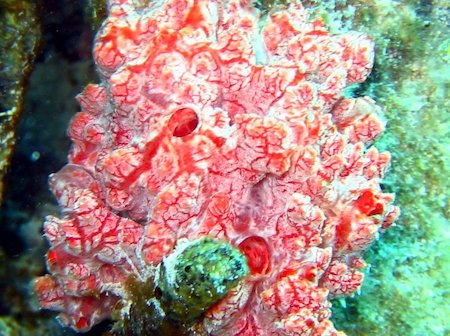
While most sponges are only a few centimeters in size, some are even smaller, less than a centimeter (0.4 inches), whereas others can grow as large as two meters (over 6 feet) in height or diameter.
No matter their size, sea sponges are the only animals in the world that don’t have any body symmetry at all. That means they don’t have “mirror halves” like humans, where if you cut the body down the center vertically, one side would be nearly identical to the other side. Sponges come in a variety of shapes and sizes but are not symmetrical. We’ll learn more about symmetry the next phase of the story.
Sponge: Rainbow of Colors
Living sponges span the spectrum of color; they come in red, orange, yellow, green and white as well as glowing pinks and purples.
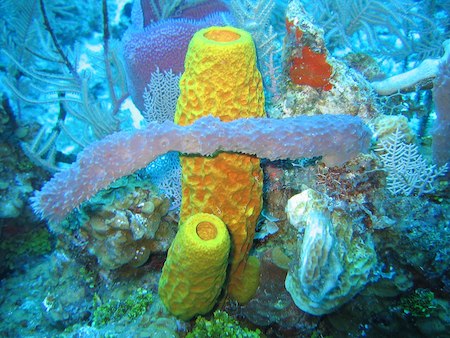
What do You and a Sponge have in Common?
You are both multicellular animals. A stretchy protein called collagen holds your cells together. Your bodies are both made of differentiated cells — meaning you have lots of specialized cells that do particular jobs.
What's Next?
A branch of the sponge family split off and evolved into a worm.
Learn More
Scientists Debate the Origin of Multicellularity
BBC: Sponges in Coral Reefs
https://www.bbc.com/news/science-environment-24398394 (2:20)
Origins of human nervous system found in sponges
https://www.livescience.com/1573-origins-human-nervous-system-sponges.html
Good bulleted facts about sponges
https://australianmuseum.net.au/learn/animals/sea-stars/sponges/
640 MYA Sponges appear, ahead of comb jellies
https://www.youtube.com/watch?v=cKfNVYCu6Us
Dr. Christina Diaz, great video on sponges
https://www.shapeoflife.org/video/sponges-origins
